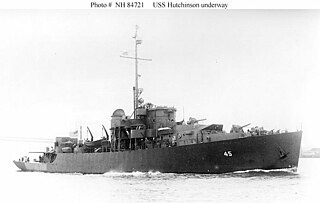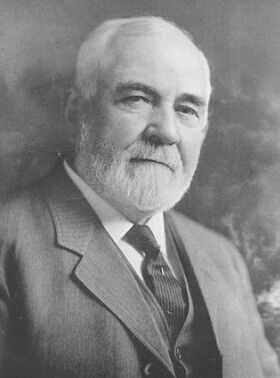
USS Wyoming was the second ship of the United States Navy to bear that name, but the first to bear it in honor of the 44th state. The first Wyoming was named for Wyoming Valley in eastern Pennsylvania.

USS Seawolf (SS-197), a Sargo-class submarine, was the second submarine of the United States Navy named for the seawolf.

The first USS South Dakota (ACR-9/CA-9), also referred to "Armored Cruiser No. 9", and later renamed Huron, was a United States Navy Pennsylvania-class armored cruiser.

USS F-1 (SS-20) was an F-class submarine. She was named Carp when her keel was laid down by Union Iron Works of San Francisco, California, making her the first ship of the United States Navy named for the carp. She was launched on 6 September 1911 sponsored by Ms. J. Tynan, renamed F-1 on 17 November 1911, and commissioned on 19 June 1912.

USS S-4 (SS-109) was an S-class submarine of the United States Navy. In 1927, she was sunk by being accidentally rammed by a United States Coast Guard destroyer with the loss of all hands but was raised and restored to service until stricken in 1936.

USS R-7 (SS-84) was an R-class coastal and harbor defense submarine of the United States Navy.

USS R-6 (SS-83) was an R-class coastal and harbor defense submarine of the United States Navy.

USS H-2 (SS-29) was a H-class submarine. She was originally named Nautilus, the third ship and first submarine of the United States Navy to bear the name, which was derived from a Greek word meaning "sailor" or "ship." The nautilus is also a tropical mollusk having a many-chambered, spiral shell with a pearly interior. It was also the name of the fictional submarine in Jules Verne's novel Twenty Thousand Leagues Under the Sea which was prophetic of submarine technology.

USS H-3 (SS-30) was a H-class submarine originally named Garfish, the only ship of the United States Navy named for the gar, a popular target for recreational anglers.

The second USS Milwaukee (C-21) was a St. Louis-class protected cruiser in the United States Navy. Entering service in 1906, Milwaukee was deployed to the Pacific Ocean. On 13 January 1917, while aiding a grounded submarine, the cruiser grounded herself. The ship was decommissioned and sold for scrap in 1919.

USS Moody (DD-277) was a Clemson-class destroyer in the United States Navy in commission from 1919 to 1922 and from 1923 to 1930. She was named for Justice William Henry Moody.

USS Currier (DE-700) was a Buckley-class destroyer escort in service with the United States Navy from 1944 to 1960. She was sunk as a target in 1967.

USS Hutchinson (PF-45), a Tacoma-class frigate, was the only ship of the United States Navy to be named for Hutchinson, Kansas.

USS Walton (DE-361) was a John C. Butler-class destroyer escort in the United States Navy. It was named after Merrit Cecil Walton, a Marine Corps platoon sergeant with the U.S. 1st Marine Division, who died on Gavutu during the Battle of Guadalcanal and was posthumously awarded the Navy Cross for "extraordinary heroism".

The second USS Monterey was the sole Monterey-class monitor. Laid down by Union Iron Works, San Francisco, California, 20 December 1889, she was launched 28 April 1891, sponsored by Miss Kate C. Gunn. She was commissioned 13 February 1893.

USS Bangor (PF-16) was a United States Navy Tacoma-class frigate in commission from 1944 to 1946. Thus far, she has been the only U.S. Navy ship named for Bangor, Maine. She later served in United States Coast Guard as USCGC Bangor and in the Mexican Navy as ARM General José María Morelos and ARM Golfo de Tehuantepec.

USS Flamingo (AM-32) was a Lapwing-class minesweeper built for the United States Navy near the end of World War I. After service overseas clearing mines after the Armistice, the ship was laid up until 1922 when she was transferred to the United States Department of Commerce for use by the United States Coast and Geodetic Survey. Renamed USC&GS Guide, the ship operated as a survey vessel along the West Coast of the United States for 17 years, making significant contributions to navigation, hydrographic surveying, and oceanography. In June 1941, Guide was transferred back to the Navy, converted into a salvage ship, and renamed USS Viking (ARS-1). As Viking, she worked primarily from bases in California until 1953, when she was sold for scrapping.

The United States H-class submarines were Electric Boat design EB26A and EB26R design coastal patrol submarines used by the United States Navy.

USS Richard M. Rowell (DE-403) was a John C. Butler-class destroyer escort acquired by the United States Navy during World War II. The primary purpose of the destroyer escort was to escort and protect ships in convoy, in addition to other tasks as assigned, such as patrol or radar picket. During her career she earned six battle stars to her credit.

Craig Shipbuilding was a shipbuilding company in Long Beach, California. To support the World War I demand for ships Craig Shipbuilding shipyard switched over to military construction and built: US Navy Submarines and Cargo Ships. Craig Shipbuilding was started in 1906 by John F. Craig. John F. Craig had worked in Toledo, Ohio with his father, John Craig (1838-1934), and Blythe Craig, both shipbuilders, their first ship was built in 1864 at Craig Shipbuilding Toledo. John F. Craig opened his shipbuilding company in Port of Long Beach on the south side of Channel 3, the current location of Pier 41 in the inner harbor, becoming the port's first shipyard. In 1908 Craig Shipbuilding was given the contract to finishing dredging of the Port of Long Beach inner harbor and to dredge the channel connecting it to the Pacific ocean. In 1917 Craig sold the shipyard to the short-lived California Shipbuilding Company. but then opened a new shipyard next to the one he just sold and called it the Long Beach Shipbuilding Company. The Long Beach Shipbuilding Company built cargo ships in 1918, 1919, and 1920 for the United States Shipping Board.





















